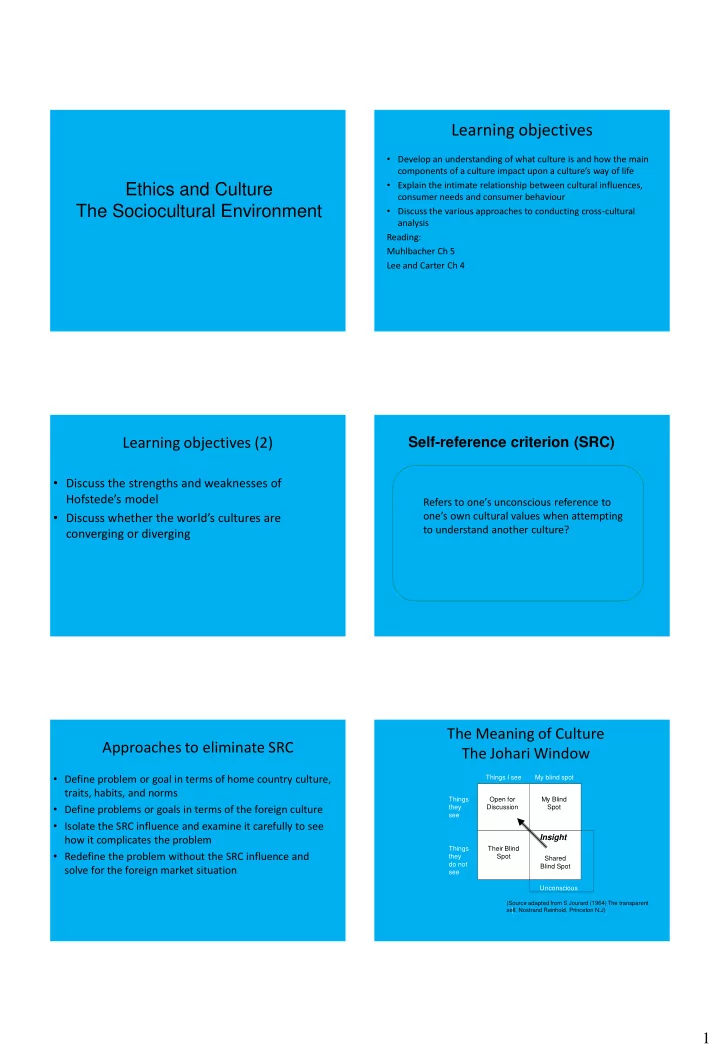

Learning objectives • Develop an understanding of what culture is and how the main components of a culture impact upon a culture’s way of life • Explain the intimate relationship between cultural influences, Ethics and Culture consumer needs and consumer behaviour The Sociocultural Environment • Discuss the various approaches to conducting cross-cultural analysis Reading: Muhlbacher Ch 5 Lee and Carter Ch 4 Learning objectives (2) Self-reference criterion (SRC) • Discuss the strengths and weaknesses of Hofstede’s model Refers to one’s unconscious reference to • Discuss whether the world’s cultures are one’s own cultural values when attempting to understand another culture? converging or diverging The Meaning of Culture Approaches to eliminate SRC The Johari Window • Define problem or goal in terms of home country culture, Things I see My blind spot traits, habits, and norms Things Open for My Blind • Define problems or goals in terms of the foreign culture they Discussion Spot see • Isolate the SRC influence and examine it carefully to see Insight how it complicates the problem Things Their Blind • Redefine the problem without the SRC influence and they Spot Shared do not Blind Spot solve for the foreign market situation see Unconscious (Source adapted from S Jourard (1964) The transparent self, Nostrand Reinhold, Princeton N.J) ( 1
More Definitions Culture • A distinctive pattern of values and beliefs which are characteristic of a Culture is the collective particular society or sub-group within programming of the mind which that society.” Mullins (2005) distinguishes the members of one human group from another. It is the learned ways in which a • “a set of beliefs or standards, shared society understands, decides and by a group of people, which helps the communicates. individual decide what is, what can be, Hofstede (1980) how to feel, what to do and how to go about doing it.” Goodenough (1940) The visible and invisible parts of culture Characteristics of culture • Culture is learned • Culture is interrelated • Culture is shared A Cultural Framework - Terpstra and Sarathy (2000) Layers of culture Language Religion Values and National culture Attitudes Business/industry culture Company culture Aesthetics Cultures Education Individual behaviour/ decision maker Law and Technology Social Politics and Material Organisation Culture 2
Understanding Culture and Consumer Behaviour Approaches to the Study of Culture • Maslow (1970): Hierarchy of Needs • Lee (1966): Self Reference Criteria • Hall’s (1977): High and Low Context Cultures • Hofstede (2001, 1997): The four dimensions of power distance, individualism and masculinity and uncertainty avoidance Comparing low- and high-context cultures (1) Hall’s Communication Context Characteristic Low-context High-context Low-context High-context Communication Explicit, direct Implicit, indirect cultures cultures Sense of self Formal hugs, bows, Informal handshakes and handshakes and space Short video : http://www.youtube.com/watch?v=6gJzRS0I7tA&feature=related Comparing low- and high-context cultures (2) Comparing low- and high-context cultures (3) Characteristic Low-context High-context Characteristic Low-context High-context Indication of Linear, exact, Dress Time Varies widely, Elastic, relative, position in society, promptness is valued, and appearance dress for success consciousness time = relationships religious rule time = money Nuclear family, Extended family, Food Family and Eating is a Eating is social event self-oriented, other oriented, and eating habits necessity, fast food friends value youth loyalty 3
Comparing low- and high-context cultures (4) Comparing low- and high-context cultures (5) Characteristic Low-context High-context Characteristic Low-context High-context Linear, logical, Independence, Lateral, holistic, Mental process Group conformity, sequential, Values and norms confrontation accepting harmony and learning problem solving life’s difficulties of conflict Hierarchical, Egalitarian, Relationship oriented, Beliefs and Business/ respect for authority, Deal oriented, rewards challenge authority, rewards based attitudes gender roles work habits based on achievement gender equity on seniority The contextual continuum of differing cultures Hofestede Dimensions video • (Acknowledgement BBB Marketing) The role of language Sensuality and touch culture in Saudi Arabian versus European advertising • Language is important in information gathering and evaluation efforts • Language provides access to local society • Language capability is important to company communications • Language enables the interpretation of context 4
Hofstede’s model of national cultures Cultural similarities and differences Hofstede’s (1990) cultural distance framework: Power distance Power distance (authority) Uncertainty avoidance (control of aggression and emotional Uncertainty avoidance expression) Time perspective or Individualism vs. Collectivism (relationship between individual and Confucian Dynamism group) Individualism/ Collectivism Masculinity vs. Femininity (social implications of self-discipline) Long-term orientation (emphasized duration of return) Masculinity / Femininity (Source: Hofstede, 1990; Hickson & Pugh, 2001; Hofstede & Hofstede, 2004) Convergence of world’s cultures Cultural similarities and differences (Source: Hofstede, 1990; Hickson & Pugh, 2001) Source: http://www.mtv.co.uk Seminar Activity Cultural Environment - Video and Questions Globalisation Debate Open the following website watch the video and answer the questions http://wps.pearsoned.co.uk/ema_uk_he_hollensen_globalmark_4/64/16424/4204693.cw/ind ex.html Globalization seems inevitable, but it is not without controversy. Questions: The debate on globalization will continue as people try to 1. Language can be a barrier to effective communication. What steps can a make sure that the benefits of global trade outweigh the costs company take to minimize language barriers across borders? for all countries, not just a select few… 2. Cultural differences need to be considered when communicating across borders. What characteristics of a country's culture need to be researched to ensure business success across borders? 3. The video mentions that some companies have trusted contacts in a country they wish to do business with, while other companies rely on a http://winmedia.leg.akamai.pearsoncmg.com/intl/ema_uk_he_hollensen_globmark_4e/globalization_256.wmv Video 15mins significant amount of research to learn more about culture characteristics, etc. What method do you feel is most effective for gathering useful, accurate, and up-to-date information regarding cultural issues? 5
Recommend
More recommend